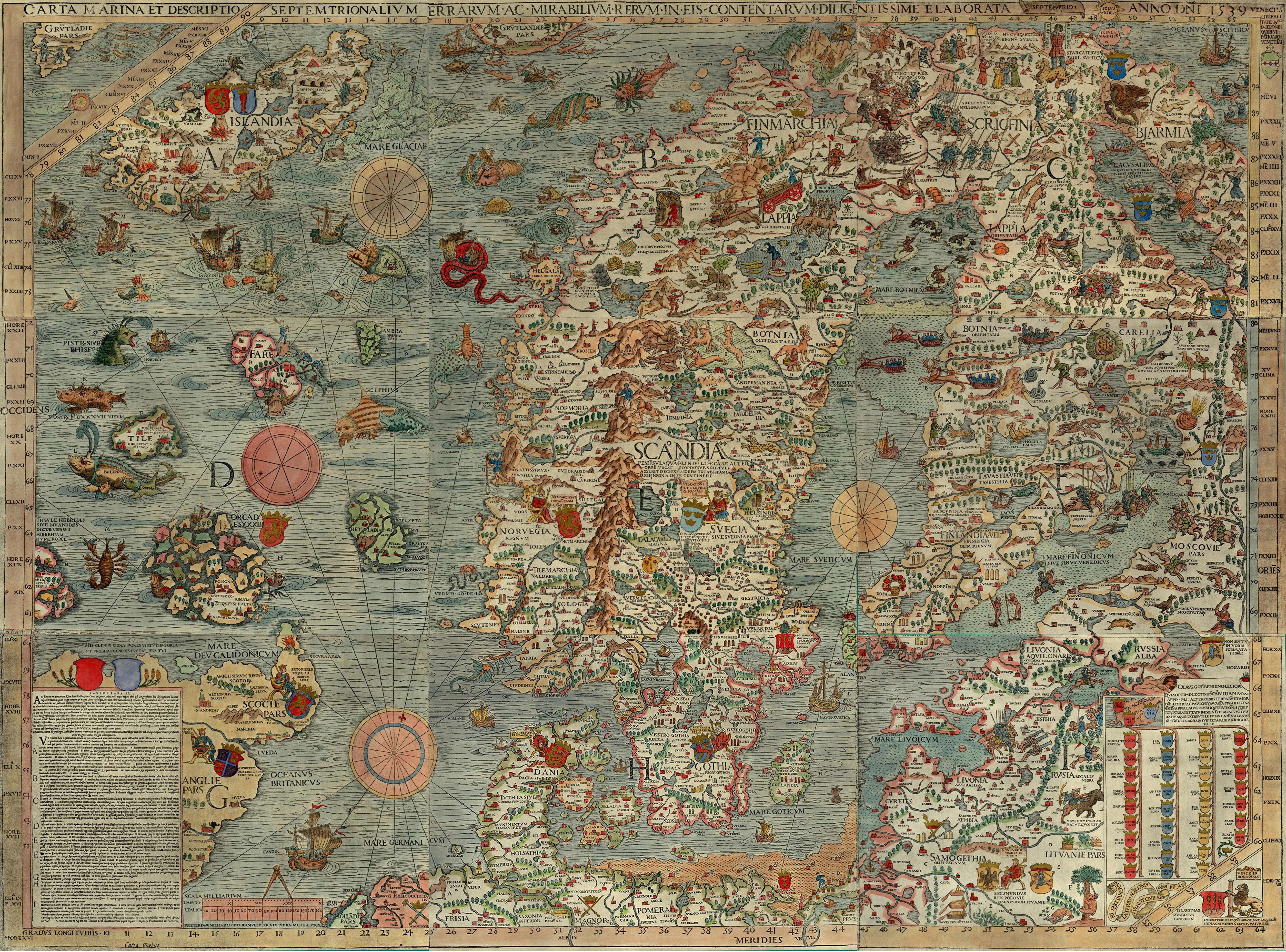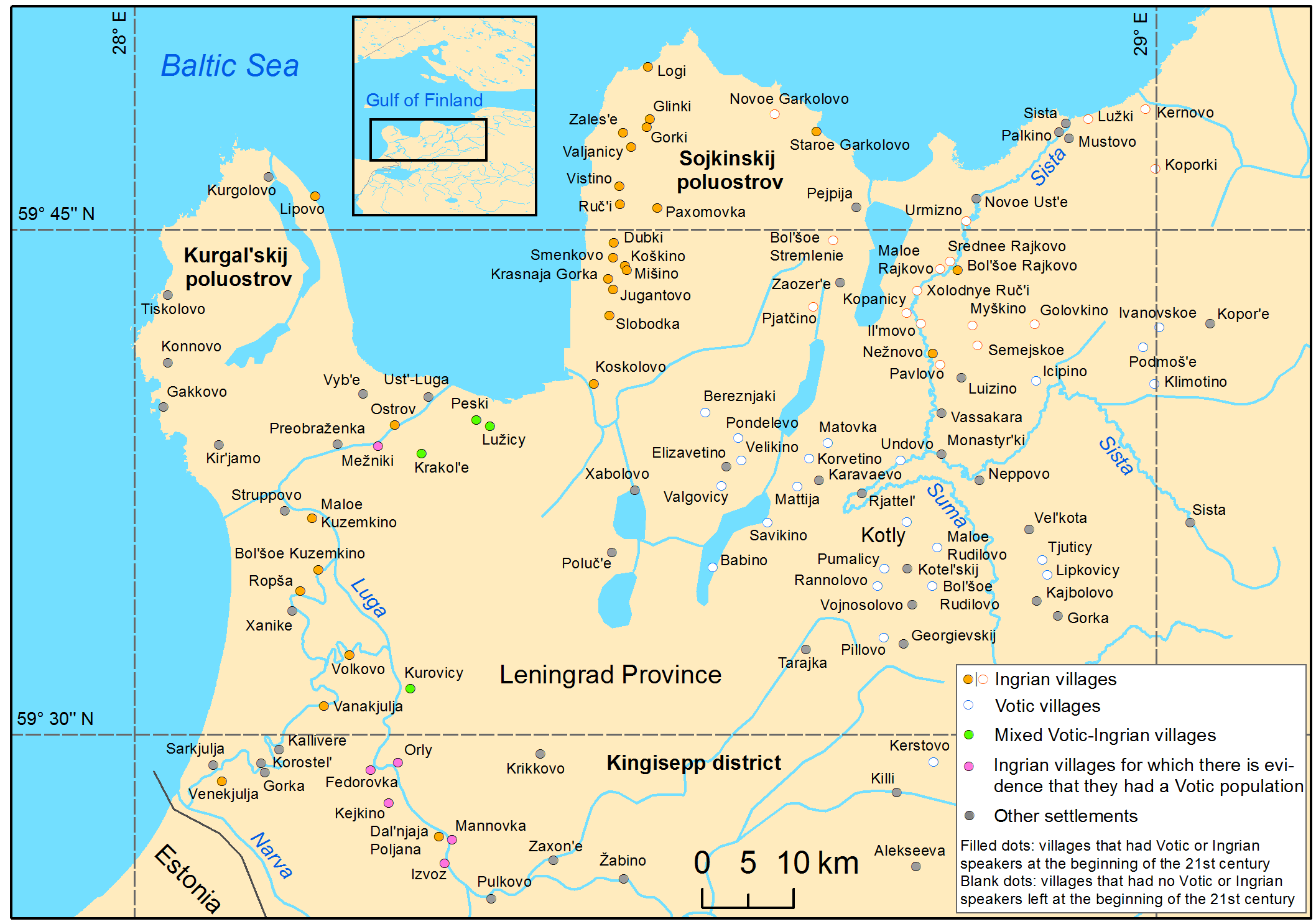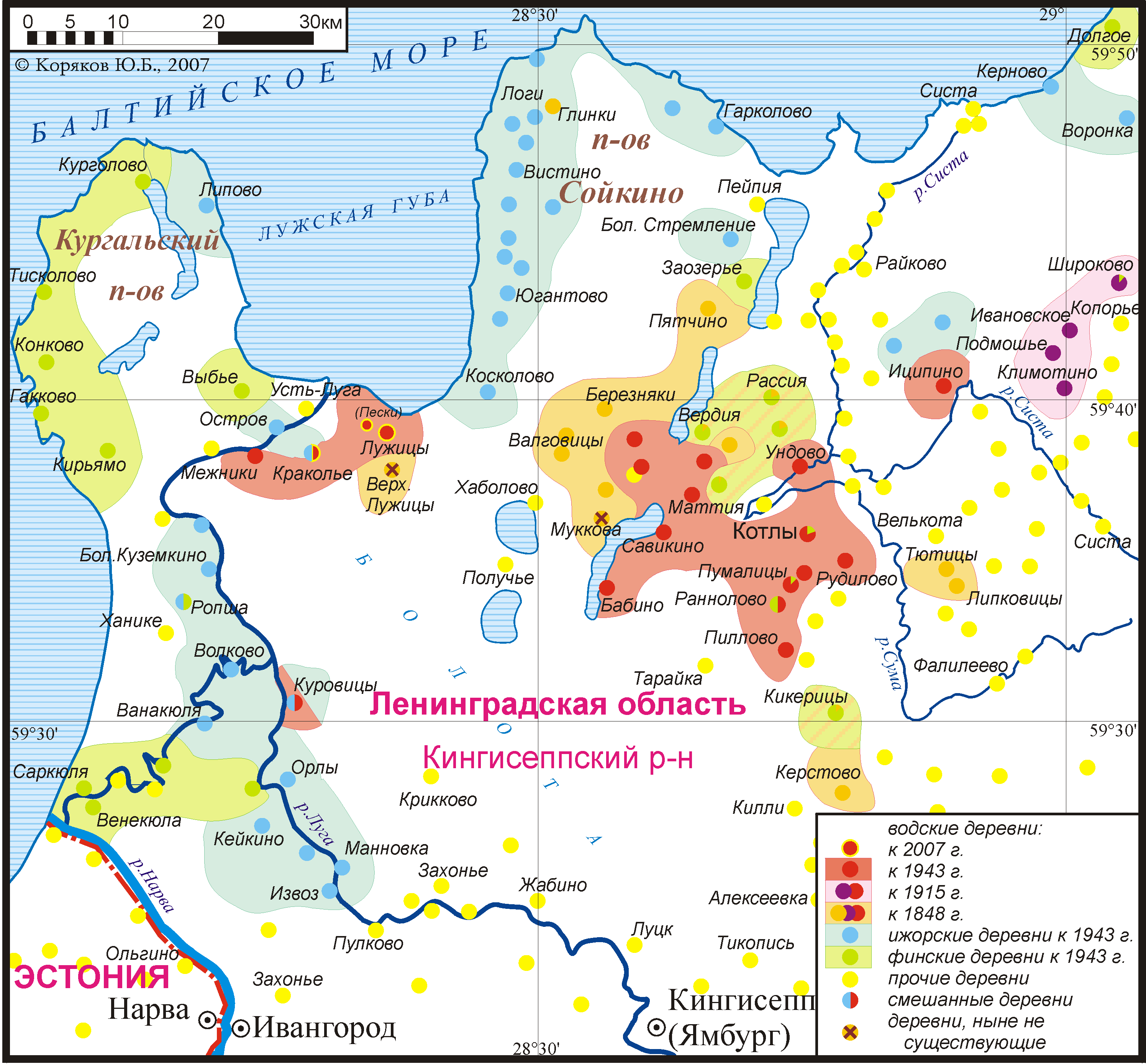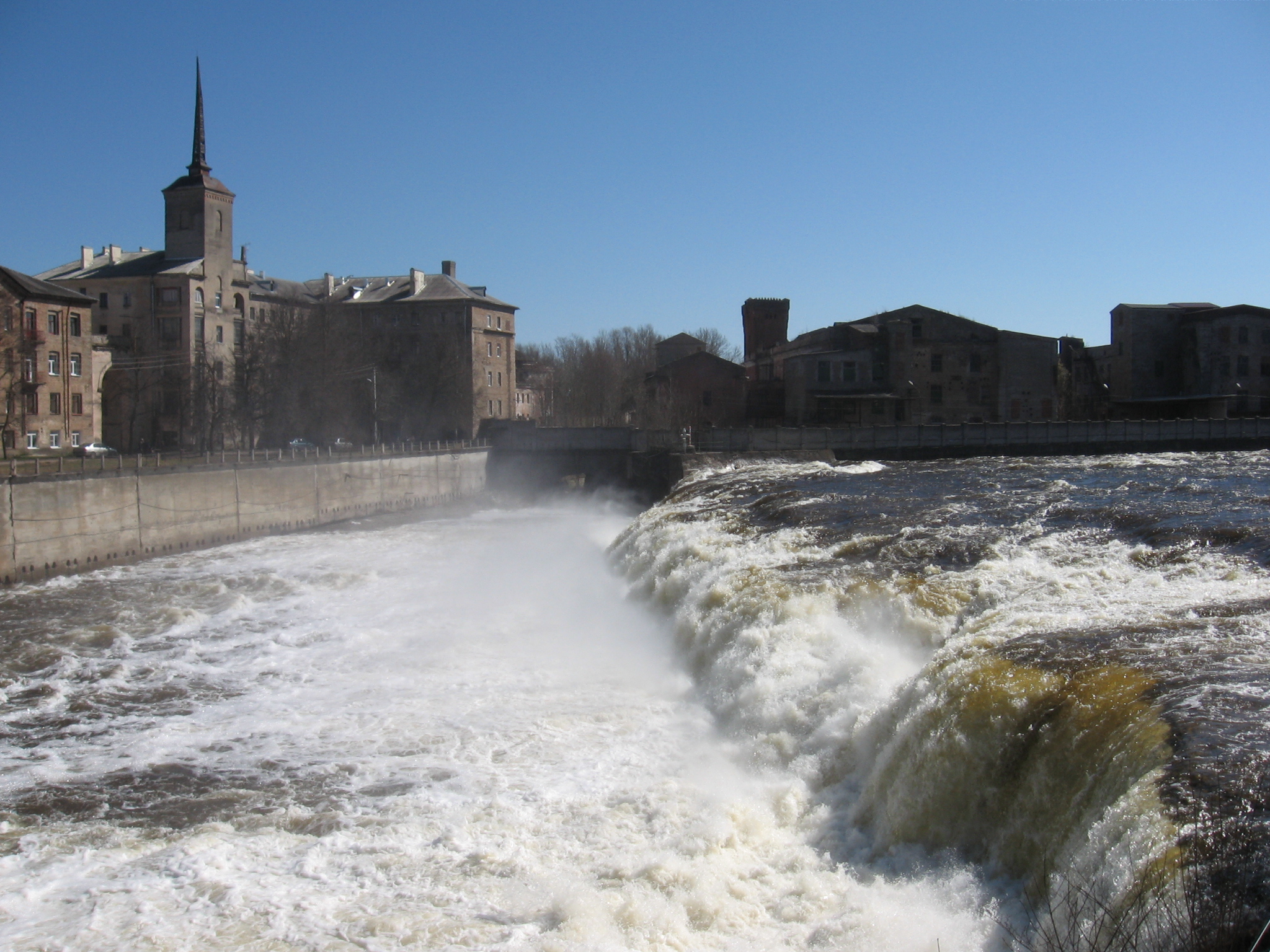|
Ingria
Ingria (; ; ; ) is a historical region including, and adjacent to, what is now the city of Saint Petersburg in northwestern Russia. The region lies along the southeastern shore of the Gulf of Finland, bordered by Lake Ladoga on the Karelian Isthmus in the north and by the Narva river on the current international border with Estonia in the west. The earliest known inhabitants of the region were indigenous Finnic peoples, primarily the ancestors of modern Izhorians and Votians, who converted to Eastern Orthodox Christianity during the late Middle Ages. They were later joined by the Ingrian Finns, descendants of 17th century Lutheran Finnish immigrants. At that time, Ingria, the Karelian Isthmus, Estonia, and what is now Finland were all part of the Kingdom of Sweden. Ingria as a whole never formed a separate state; however, North Ingria was an independent state for just under two years in 1919–1920. The inhabitants of Ingria cannot be said to have comprised a distinct n ... [...More Info...] [...Related Items...] OR: [Wikipedia] [Google] [Baidu] |
Ingrian Language
Ingrian (, ), also called Izhorian (, , ), is a Finnic language spoken by the (mainly Orthodox) Izhorians of Ingria. It has approximately 70 native speakers left, most of whom are elderly. The Ingrian language should be distinguished from the Ingrian dialect of the Finnish language, which became the majority language of Ingria in the 17th century with the influx of Lutheran Finnish immigrants; their descendants, the Ingrian Finns, are often referred to as Ingrians. The immigration of Lutheran Finns was promoted by Swedish authorities, who gained the area in 1617 from Russia, as the local population was (and remained) Orthodox. Dialects Four dialect groups of Ingrian have been attested, two of which are probably extinct by now: * Hevaha, spoken along Kovashi River and nearby coastal areas (†) * Soikkola, spoken on Soikinsky Peninsula and along Sista River * Ylä-Laukaa (Upper Luga or Oredezhi), spoken along Oredezh River and the upper Luga River (†) * Ala-Laukaa (Lo ... [...More Info...] [...Related Items...] OR: [Wikipedia] [Google] [Baidu] |
Ingrian Finns
Ingrian Finns (, ; ) are the Finnish people, Finnish population of Ingria (now the central part of Leningrad Oblast in Russia), descending from Lutheranism, Lutheran Finnish immigrants introduced into the area in the 17th century, when Finland and Ingria were both parts of the Swedish Empire. Before and after World War II, most of them were relocated to other parts of the Soviet Union or killed, in Soviet campaigns directed towards their Deportations of the Ingrian Finns, forced deportation and Genocide of the Ingrian Finns, genocide. Today the Ingrian Finns constitute the largest part of the Finnish population of the Russian Federation. According to some records, some 25,000 Ingrian Finns have returned or still reside in the region of Saint Petersburg. They are also referred to as Ingrians, although the term can also refer to the Izhorians or the Baltic Finnic residents of Ingria in general. History Origins Ingrian Finns are the indigenous minority of Europe. Finnish-speakin ... [...More Info...] [...Related Items...] OR: [Wikipedia] [Google] [Baidu] |
North Ingria
The Republic of Kirjasalo (), commonly known as the Republic of North Ingria () was a short-lived unrecognized state from 9 July 1919 to 5/6 December 1920.Most Finnish-language sources state 5 December 1920 as the date when the republic was dissolved, however Russian-language sources state 6 December 1920 as the date when the republic was dissolved. Kirjasalo was located in the southern part of the Karelian Isthmus, specifically in Kirjasalo in Lempaala. Government and the Republic Kirjasalo was in control of , controlling five villages, having around 400 total population.Includes Military volunteers, Civil Guardsmen, and Finns and Ingrian Finns that moved to the controlled villages temporarily. Kirjasalo had its own local Protection Corps and local newspaper '. Kirjasalo had its own military regiment, the , which was composed of 580–1,700 military volunteers, and led by Georg Elfvengren, prior to being sacked and being replaced by . The official flag and coat of arm ... [...More Info...] [...Related Items...] OR: [Wikipedia] [Google] [Baidu] |
Izhorians
The Izhorians (; ; ; ) are a Finnic indigenous people native to Ingria. Small numbers can still be found in the western part of Ingria, between the Narva and Neva rivers in northwestern Russia. They are also referred to as Ingrians, although the term can also refer to the Ingrian Finns or the Baltic Finnic residents of Ingria in general. History The history of the Izhorians is bound to the history of Ingria. It is supposed that shortly after 1000 AD the Izhorians moved from Karelia to the west and south-west. In 1478, the Novgorod Republic, where Ingrians had settled, was united with the Grand Duchy of Moscow, and some of the Izhorians were transferred to the east. The establishment of St Petersburg in 1703 had a great influence on Izhorian culture. World War II had the biggest impact on Izhorians, as devastating battles (such as the Siege of Leningrad) took place on their territory. In 1848, P. von Köppen counted 17,800 Izhorians, and by 1926 there were 26,137 Izhorians ... [...More Info...] [...Related Items...] OR: [Wikipedia] [Google] [Baidu] |
Votians
Vots, also referred to as Votes, Vods and Votians (, ''vađđalaizõd''; ; ; ) are a Baltic Finns, Finnic ethnic group native to historical Ingria, the part of modern-day northwestern Russia that is roughly southwest of Saint Petersburg and east of the Estonian border-town of Narva. The Finnic languages, Finnic Votic language spoken by Vots is close to Language death, extinction. The language is still spoken in three villages of historical Votia and by an unknown number of speakers in the countryside. The villages are ''Jõgõperä'' (Krakolye), ''Liivcülä'' (Peski), and ''Luuditsa'' (Luzhitsy).Eesti Rahva Muuseum: Vadjalased Archived In the Russian 2020 ... [...More Info...] [...Related Items...] OR: [Wikipedia] [Google] [Baidu] |
Karelian Isthmus
The Karelian Isthmus (; ; ) is the approximately stretch of land situated between the Gulf of Finland and Lake Ladoga in northwestern Russia, to the north of the River Neva. Its northwestern boundary is a line from the Bay of Vyborg to the westernmost point of Lake Ladoga, Pekonlahti. If the Karelian Isthmus is defined as the entire territory of present-day Saint Petersburg and Leningrad Oblast to the north of the Neva and also a tiny part of the Republic of Karelia, the area of the isthmus is about . The smaller part of the isthmus to the southeast of the old Russia-Finland border is considered historically as Northern Ingria, rather than part of the Karelian Isthmus itself. The rest of the isthmus was historically a part of Finnish Karelia. This was conquered by the Russian Empire during the Great Northern War in 1712 and included within the autonomous Grand Duchy of Finland (1809–1917) of the Russian Empire. When Finland became independent in 1917, the isthmus (excep ... [...More Info...] [...Related Items...] OR: [Wikipedia] [Google] [Baidu] |
Finnish People
Finns or Finnish people (, ) are a Baltic Finns, Baltic Finnic ethnic group native to Finland. Finns are traditionally divided into smaller regional groups that span several countries adjacent to Finland, both those who are native to these countries as well as those who have resettled. Some of these may be classified as separate ethnic groups, rather than subgroups of Finns. These include the Kvens and Forest Finns in Norway, the Tornedalians in Sweden, and the Ingrian Finns in Russia. Finnish language, Finnish, the language spoken by Finns, is closely related to other Balto-Finnic languages such as Estonian language, Estonian and Karelian language, Karelian. The Finnic languages are a subgroup of the larger Uralic languages, Uralic family of languages, which also includes Hungarian language, Hungarian. These languages are markedly different from most other languages spoken in Europe, which belong to the Indo-European languages, Indo-European family of languages. Native Finns c ... [...More Info...] [...Related Items...] OR: [Wikipedia] [Google] [Baidu] |
Gulf Of Finland
The Gulf of Finland (; ; ; ) is the easternmost arm of the Baltic Sea. It extends between Finland to the north and Estonia to the south, to Saint Petersburg—the second largest city of Russia—to the east, where the river Neva drains into it. Other major cities around the gulf include Helsinki and Tallinn. The eastern parts of the gulf belong to Russia, and some of Russia's most important oil harbors are located there, including Primorsk, Leningrad Oblast, Primorsk. As the seaway to Saint Petersburg, the gulf is of considerable strategic importance to Russia. Some of the Baltic Sea#Environmental status, environmental problems affecting the Baltic Sea are at their most pronounced in the shallow gulf. Proposals for an undersea tunnel, undersea Helsinki–Tallinn Tunnel through the gulf have been made. Geography The Gulf of Finland has an area of . The length (from the Hanko Peninsula to Saint Petersburg) is and the width varies from near the entrance to on the meridian of Mo ... [...More Info...] [...Related Items...] OR: [Wikipedia] [Google] [Baidu] |
Saint Petersburg
Saint Petersburg, formerly known as Petrograd and later Leningrad, is the List of cities and towns in Russia by population, second-largest city in Russia after Moscow. It is situated on the Neva, River Neva, at the head of the Gulf of Finland on the Baltic Sea. The city had a population of 5,601,911 residents as of 2021, with more than 6.4 million people living in the Saint Petersburg metropolitan area, metropolitan area. Saint Petersburg is the List of European cities by population within city limits, fourth-most populous city in Europe, the List of cities and towns around the Baltic Sea, most populous city on the Baltic Sea, and the world's List of northernmost items#Cities and settlements, northernmost city of more than 1 million residents. As the former capital of the Russian Empire, and a Ports of the Baltic Sea, historically strategic port, it is governed as a Federal cities of Russia, federal city. The city was founded by Tsar Peter the Great on 27 May 1703 on the s ... [...More Info...] [...Related Items...] OR: [Wikipedia] [Google] [Baidu] |
Narva (river)
The Narva, formerly also Narwa or Narova, flows north into the Baltic Sea and is the largest Estonian river by Discharge (hydrology), discharge. A similar length of land far to the south, together with it and a much longer intermediate lake, Lake Peipus, all together nowadays form the international border between Estonia and Russia. The river gives its name to the archaeological culture, archaeological (Neolithic Europe, Neolithic) Narva culture, as well as the city of Narva. Narva is the third most populous urban area in Estonia, and nowadays faces the Russian town of Ivangorod right across the border over the river. At the coast the river passes part of the resort of Narva-Jõesuu. Its mouth opens into boxing the compass, WNW-facing Narva Bay of the Gulf of Finland. Narva gives the second-greatest discharge into the Gulf of Finland (the greatest discharge comes from the Neva River). Etymology The etymology of the toponym ''Narva'' is not clear. According to one hypothesis i ... [...More Info...] [...Related Items...] OR: [Wikipedia] [Google] [Baidu] |
Estonia
Estonia, officially the Republic of Estonia, is a country in Northern Europe. It is bordered to the north by the Gulf of Finland across from Finland, to the west by the Baltic Sea across from Sweden, to the south by Latvia, and to the east by Russia. The territory of Estonia consists of the mainland, the larger islands of Saaremaa and Hiiumaa, and over 2,300 other islands and islets on the east coast of the Baltic Sea. Its capital Tallinn and Tartu are the two largest List of cities and towns in Estonia, urban areas. The Estonian language is the official language and the first language of the Estonians, majority of its population of nearly 1.4 million. Estonia is one of the least populous members of the European Union and NATO. Present-day Estonia has been inhabited since at least 9,000 BC. The Ancient Estonia#Early Middle Ages, medieval indigenous population of Estonia was one of the last pagan civilisations in Europe to adopt Christianity following the Northern Crusades in the ... [...More Info...] [...Related Items...] OR: [Wikipedia] [Google] [Baidu] |
Lutheranism
Lutheranism is a major branch of Protestantism that emerged under the work of Martin Luther, the 16th-century German friar and Protestant Reformers, reformer whose efforts to reform the theology and practices of the Catholic Church launched the Reformation in 1517. The Lutheran Churches adhere to the Bible and the Ecumenical Creeds, with Lutheran doctrine being explicated in the Book of Concord. Lutherans hold themselves to be in continuity with the apostolic church and affirm the writings of the Church Fathers and the first four ecumenical councils. The schism between Roman Catholicism and Lutheranism, which was formalized in the Diet of Worms, Edict of Worms of 1521, centered around two points: the proper source of s:Augsburg Confession#Article XXVIII: Of Ecclesiastical Power., authority in the church, often called the formal principle of the Reformation, and the doctrine of s:Augsburg Confession#Article IV: Of Justification., justification, the material principle of Luther ... [...More Info...] [...Related Items...] OR: [Wikipedia] [Google] [Baidu] |








